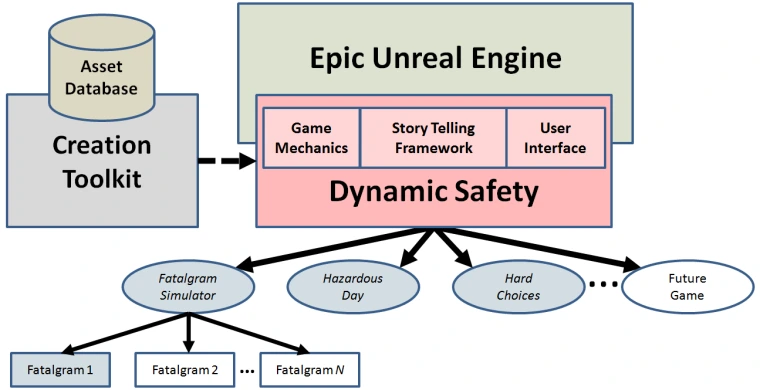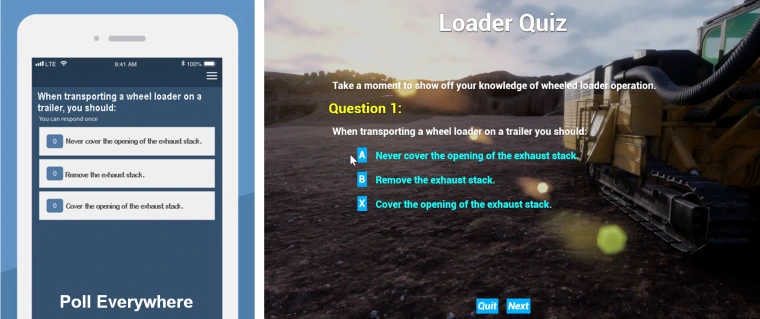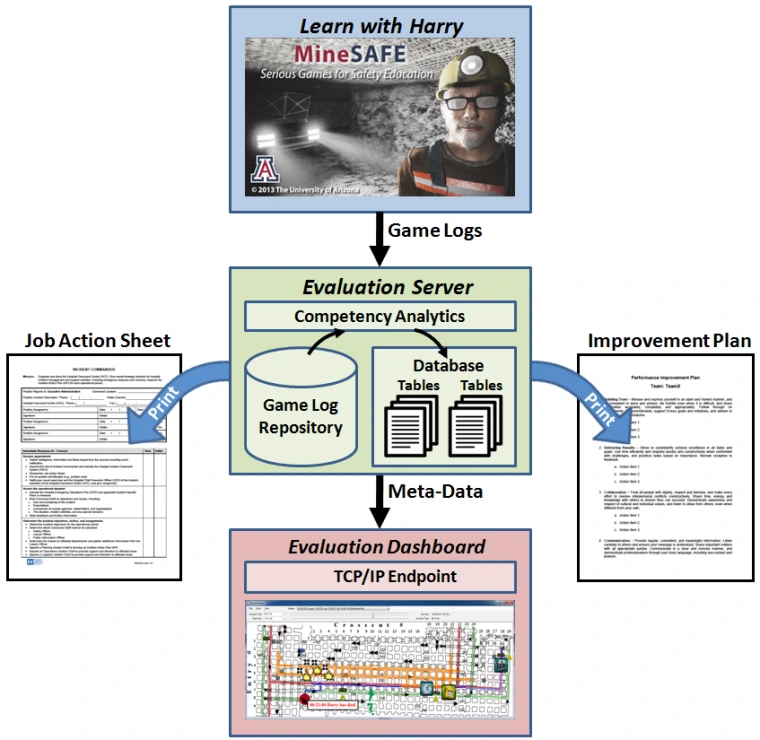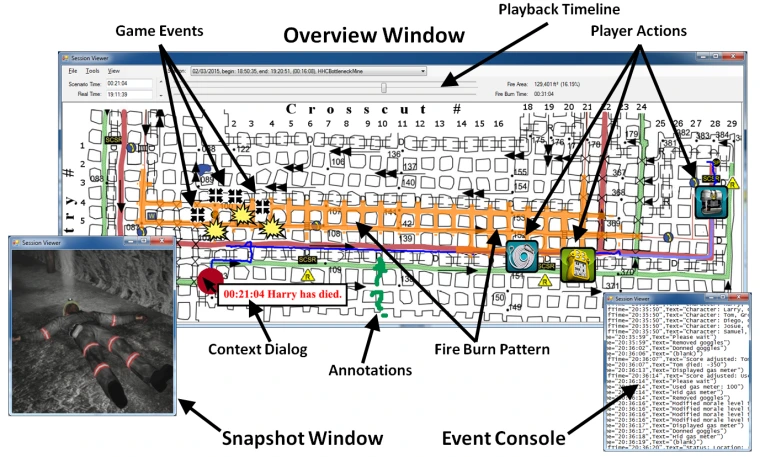
Technical Overview
Through a triangulated needs assessment, the Center has identified a new training workflow for mine safety that addresses key gaps and deficiencies using Synthetic Learning Environments (SLEs). To support this effort, the Lowell Institute for Mineral Resources has developed a specialized software platform called Dynamic Safety™, which is built upon a commercially available, AAA game engine called Unreal Engine, by Epic Games. This high-end game engine was chosen as the basis for our platform due to its robust capabilities, including a well-established game development workflow that supports rapid prototyping and customization; a high-performance rendering engine with programmable shaders and robust animation options that allow us to render complex, life-like mine environments; a complete physics engine of simulating complex mine sites, machinery, and rock mechanics; and the ability to support multiple users (local host, LAN, or internet) operating within the same virtual workspace and across different hardware platforms.
The Dynamic Safety platform is composed of four software modules, visualized in the diagram above. An interaction framework allows for a variety of display and control devices which maximize capability based on the level of available instructional technologies. Dynamic Safety applications will run on mid-range personal computers, tablets, smartphones, and Virtual Reality (VR) displays; they can be controlled by keyboards, gamepads, touch screens, and VR controllers. A story-telling framework enables open worlds with emergent stories that allow freedom of will and respond appropriately to learner decision-making. A system of game mechanics may be used to objectify consequences and provide both qualitative and quantitative feedback on outcomes suitable for evaluation and debriefing purposes. Finally, a creation toolkit allows for the construction of a many training scenarios, with assets to localize the content for specific regions, sites, workers, and procedures.
The platform and underlying game engine provide a set of enabling capabilities so that our synthetic learning environments meet all of the empirically derived Design Guidelines for Training in Mine Safety. A summary of these key capabilities is given in the table below. Further discussion on the platform technical design and implementation may be found in Brown (2015).[1]
Quick Facts: Dynamic Safety™ Platform Capabilities
| Anytime Access | Users may log into the synthetic learning environment at any time. Use in the classroom, on the worksite, or at home. |
| Analytics | Generate reports and grades based on site-specific SOPs or competency models and analyze the performance of users, crews, and shifts over time. |
| Emergent Stories | Inject randomization into the scenario and let the story unfold based on users’ role-play activities, enabling experimentation and evaluation. |
| Gamification | aming elements built into each application, including character development, humorous consequences, and endogenous rewards and penalties based on user choices. |
| Logging | Track and maintain a history of all user activities within the synthetic learning environment, including key decisions, attentiveness, and communications. |
| LMS Integration | SCORM-compliant output allows for integration with learning management systems. Extended capabilities are available for select LMS systems. |
| Modular | Choose scenarios and hazards based on your training needs. Generic hazards and incidents based on the Top 20 for each sector. |
| Multi-Platform | Play on PCs, tablets, phones, or Virtual Reality headsets. |
| Multiplayer | A large number of users may play cooperatively or competitively in the same learning environment, on a LAN or through the internet. |
| Persistent | Decisions made (or not made) in one session can carry over to other sessions and have consequences. Modifications to the environment are synchronized and visible to all other users and persist across sessions. |
| Reality-Based | Play through tough, realistic scenarios that are grounded in simulation, with realistic physics and outcomes. |
| Replayable | Randomized story elements provide for user practice and experimentation, while pre-defined scenarios support a standardized competency evaluation. |
| Sandbox | An open world design allows users freedom of movement, action, and will. |
| Scenario-Based | Play specific modules to address targeted competencies or a longer story to explore more complex behaviors and interactions. |
| Selectable Maps | Play in one of our generic work environments or your own. For mining, a variety of generic surface and underground facilities are available. |
| Team-Based | In-game voice and chat coupled with intelligent tutoring enables a team-driven community of practice. |
By emphasizing a data-driven, safety systems approach, the Dynamic Safety platform was designed to support a range of organizational training, assessment, and risk management uses cases. Synthetic Learning Environments may be used to track and assess all aspects of an employee's development, from pre-employment screenings through advanced skills. In that regard, SLEs can be used to plot deviations from standard operating procedures (SOPs) and assess competency based upon those SOPs. By immersing users and subjecting them to stress in-game, SLEs can uncover personality traits and identify at-risk behaviors. Furthermore, they can be used to evaluate an organization's SOPs and training for weaknesses that could lead to unanticipated safety hazards or operational inefficiency. In summary, the Center has investigated nine use cases[2] for SLEs developed with the Dynamic Safety platform, including:
- Assessing "true self" and risk-taking behaviors
- Reinforcing and evaluating core competencies
- Preparing for drills and apprenticeship
- Supplementing training for identified deficiencies
- Providing modules for scenario-based training
- Developing worker job action sheets
- Performing job hazard analysis
- Enhancing standard operating procedures
- Testing resiliency in emergency response plans

Evaluation Framework
To enhance organizational capabilities for post-session debriefing and evaluation, we have created a framework to track and evaluate learners' behaviors and activities in Synthetic Learning Environments (serious games).[3] Data mining constructs allow cross-sectional and longitudinal analysis of results at the individual, cohort, or organizational level. A conceptual overview of this framework is shown below.

The framework consists of three major components: A serious game with logging instrumentation, an evaluation server, and a dashboard:
-
Game Instrumentation: A significant strength of the Dynamic Safety platform is that it allows custom instrumentation and logging in each serious game. Low and high-level metrics allow the trainer to reconstruct nearly all aspects of a learners' gameplay for post-session debriefing and evaluation. For example, the logging system can track disaster events that are keyed to recognizable hazards ("traps"), user behaviors such as navigational strategies, online crew interactions, and decision-making speed, and scenario outcomes such as crew health and morale. The logging endpoints can be remapped to illustrate various core competencies, allowing games to be re-purposed for different training activities.
-
Evaluation Server: The server incorporates an enterprise-level relational database to aggregate game session data. The server may be cloud-based or reside on the local area network, in cases where the training site does not support internet access. The database has two parts: A game log repository stores the individual game sessions as text blobs and a collection of tables contains performance statistics. A corresponding data analytics module is used to interpret the raw game logs and populate the tables based on core competencies. Furthermore, the data analytics module can be hot-swapped and the competencies remapped in real-time, thus allowing substantial versatility in setting up the evaluation and performance thresholds. Through the evaluation server, data on game performance may be aggregated and coordinated across teams of learners or over time. Analytics outputs may then be fed to a client-side dashboard for learner debriefing or loaded into a Learning Management System (LMS) via the server's SCORM compliant output. The server architecture is compatible with all Learn with Harry games and may be used to develop leaderboards or other online reporting instruments.
-
Evaluation Dashboard: A client-side Evaluation Dashboard allows for reporting and debriefing. Game activities may be visually inspected by overlaying events onto a 2D map of the mine site and coordinated with 3D snapshots of the virtual world. The evaluation dashboard is shown below. In particular, the dashboard visualizes critical decision points and user interactions. Travel paths are illustrated by various line colors for both walking and driving of haulage, with major game events indicated by specific symbols. A notable strength of the evaluation dashboard is that it allows the trainer to step forward and backward through time, observing sequences of events leading to injuries or accidents. Furthermore, the Evaluation Dashboard also provides a reporting system to generate handouts. At present, the handout options include Job Action Sheets for individual learners and team Improvement Plans. The Job Action Sheet compiles the list of core competencies and provides an itemized accounting of user activities in the game, including a score and completion time for each safety task, whereas the Improvement Plan illustrates the top problems encountered by each team, with associated expert feedback for reflection.

Further Reading
- Brown, L. D. (2015). Design, Evaluation, and Extension of Serious Games for Training in Mine Safety. Ph.D. Dissertation, Dept. of Computer Science, Univ. of Arizona, Tucson, AZ. Available at Univ. of Arizona Libraries
- Brown, L.D., Granillo, B., & Poulton, M. (2019). "Usage Paradigms for Synthetic Learning Environments: Strategies and Lessons Learned.” SME Annual Conference and Expo, Society for Mining, Metallurgy, & Exploration. Denver, CO.
- Brown, L.D. & Granillo, B. (2018). "A Framework to Evaluate Safety Competencies Through Serious Games.” SME Annual Conference and Expo, Society for Mining, Metallurgy, & Exploration. Minneapolis, MN.

